| |
 |
Some observations to the revenues The Coat of Arms in diamond, 1875 - 1898 |
 |
|
 |
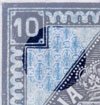
Photo 1
|
Because there are few studies of revenue stamps and the type and variations are almost unknown, I bring to the attention of readers a few varieties discovered by me, unpublished until now in the specialized papers or treated superficially. According to the three catalogues destined for revenue stamps: Cojocar, Erös, Barefoot, the issue "Coat of Arms in diamond" is divided into four distinctive issues: 1875, 1878, 1890, 1898, issues which differ among themselves through the change of the safety background, without presenting other types and variations. The study of the printing of this issues will demonstrate that their number can be higher and possibly in a totally different order. The same issues were printed at the Stamp Works, with L Kaiser hand presses on cliches manufactured in Paris. The stamps had the format of the 28.5x42 mm cliches and were printed in two colors: the border, the text and the coat of arms in black, and the safety background in different colors characteristic to each value. The first issue launched in 1875 had the following values: 5, 10, 15, 20 and 25 bani. In 1898 was introduced the 30 bani value. The cliche for the black print
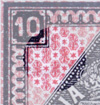
Photo 2
|
was galvanic copper, reproduced after an original hand made engraving. For the printing of the safety background were used the brass cliches, reproduced in zinc (at the National Philatelic Museum you can find the original copper mold for the border of this issue and the value cartridge which were changed according to orders). According to customs and necessities, the stamps were printed in 25 stamp sheets, with the following dimensions 250x332 mm (one such sheet present in my personal collection), or in 100 stamp sheets (private collection) sometimes using different value cliches on the same sheet. The drawing is fine and the original engraving neatly made, printed on thin, smooth, white paper. This drawing was kept until 1911, changing only the color of the safety background. These issues were not printed all at once as wrongly assumed, but were printed according to necessities, in unequal issues and at different time periods, hence the great color differences. Unfortunately, the orders to the Stamp Works are impossible to find, the archives being moved together with the factory many times so that today it is very difficult to trace them. It is left only to the studies of enthusiast collectors to clear this situation. Coming back to my personal observations, by studying a few hundred documents with these revenue stamps I observed the evolution and involution of the print. The issues starting with 1875 have a clean print, a very clear background, but as we advance in time to 1890, the background becomes more fills and hazy. At once, after 1890, the drawing is once more clear and refreshed. The only thing is that a fundamental change in the design of the background appears, not mentioned until the present. As you can observe in the adjoining images, the issues with a type 1 background (terms offered by the author of the present article) have a different drawing texture from the type 2, the most different element being the stars between the rhombs, star which at the type 1 has four rays (photo 1) and at type 2 has six rays (photo 2). All these elements lead to the conclusion that due to the wear of the original clutches, and most probably the loss of the original mould a new background mold was made after the original drawing. The graphical elements are partially respected, a typical variation appearing only after 1890 issues.
Another variety, somewhat less different and
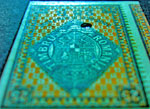
Photo 3
|
harder to discover due to special observation conditions, is generated by the type and order in which the stamps were printed. As a rule first was printed the background and then the border, avoiding thus the release in the postal, fiscal or philatelic circuit of errors such as "stamp without background", "reversed background" or "laid". The background, usually being of a very light color and the design richly ornate, in the case of the change of the printing order, a sheet without background could have easily been missed. Looking at stamps sideways at a neon light, you can observe, especially on those on the document, unaltered during washing, that sometimes the background color is printed over the black border. I tried to photograph from different angles, but in the bal ck and white images it is quite difficult to present what
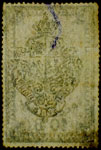
Photo 4
|
is observed in reality (photo 3).
Another variety appears at the watermark issues with the coat of arms. Rarely seen, and difficult to spot, I had a hard time finding a way of discovering them. On documents it is difficult to visualize in the absence of a special lamp, and the famous benzene lighter is no longer an accessible item. So I tried various variations using ambient light or sun light. In both situations I managed to find a few stamps with the desired watermark, but the way of discovering them was different and individualized. Some watermarks I discovered looking at the stamp through a strong, transparent source of light (photo 4), others looking sideways at a neon light (photo 5). Trying to use both observation methods I observed that the watermark seen through transparence cannot be observed regarding the surface of the stamp sideways, and vice-versa, the watermark discovered watching sideways the surface of the stamp cannot be observed through transparency. The situations presented are in the case of stamps applied on a document. The cause I suspect results
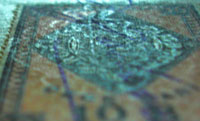
Photo 5
|
from the mode in which it was applied on the sheet during the printing process, the watermark being in fact a pseudo- watermark, printed deeper on one side of the sheet of paper than on the other, so that it is more visible in one situation than another. The watermark can also be found on four positions as on the watermark small coat of arms on Eagles and PR on the wheat chaff issues, horizontal and vertical flip, positions due to the arranging of the sheet in the printing process. The watermark in the reclined position has not been signaled.
In the hope that I caught your attention, I await from readers observations and information useful for the future study of this issues.
Francisc Ambrus, May 12, 2006
|
 |
| |

